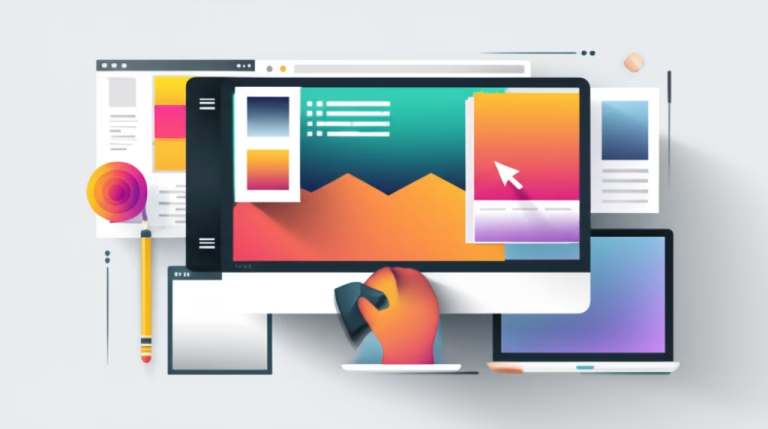The Challenge Every Designer Faces
Stepping into the design world can feel overwhelming, especially when you’re just starting out. You’ve learned the basics, maybe even completed a few practice projects. But how do you show potential clients or employers what you can do? This is where many aspiring designers hit a wall.
Without a way to present your skills and creativity effectively, getting noticed is tough. It feels like a Catch-22: you need experience to get work, but you need work to get experience. The good news? There’s a clear path forward, and it starts with building a compelling design portfolio. It’s your visual resume, your chance to shine.
Table of Contents
The Science Behind Building a Portfolio
Think of your portfolio as a curated exhibition of your best work. It’s not just a random collection of projects; it’s a strategic presentation designed to make a strong impression. The science behind a great portfolio lies in its ability to tell a story about your skills, process, and unique perspective as a designer.
It works because humans are visual creatures. We process images much faster than text. A well-structured portfolio allows someone to quickly grasp your capabilities and see the value you can bring. It builds trust and credibility, making potential opportunities much more likely to turn into reality.
Fundamental Principles
Curate Thoughtfully: Don’t include every single project you’ve ever done. Select only your strongest pieces that best represent the kind of work you want to do. Quality over quantity is key when building your design portfolio.
Show Your Process: Beyond the final outcome, explain your thinking. How did you arrive at the solution? Show sketches, wireframes, or iterations. This gives insight into your problem-solving skills as a beginner designer.
Know Your Audience: Tailor your portfolio to the types of jobs or clients you’re seeking. If you want to do branding, showcase your logo and identity projects. An effective online portfolio speaks directly to the viewer’s needs.
Practical Strategies for Your First Portfolio
Start Small: [When to use] When you have limited projects – [How to apply] Focus on 2-3 strong pieces. Detail the process behind each one extensively to add depth.
Create Personal Projects: [When to use] If you lack client work – [How to apply] Design for fictional brands or causes you care about. This shows initiative and creativity, crucial for a design career.
Use Case Studies: [When to use] For demonstrating problem-solving – [How to apply] Structure each project as a case study: outline the challenge, your role, your process, and the solution/results. This is vital to showcase design work effectively.
Get Feedback: [When to use] Before launching – [How to apply] Share your draft portfolio with mentors, peers, or friends for constructive criticism. Fresh eyes can spot areas for improvement.
Real Cases: When Portfolios Go Wrong
Learning from the missteps of others can save you time and frustration. Many new designers make common mistakes that can hinder their progress. Being aware of these pitfalls is the first step to avoiding them and building a stronger presentation of your abilities.
Case 1: The “Everything Included” Portfolio
Problem: A designer includes every piece of work they’ve ever created, regardless of quality or relevance. This dilutes the overall impact and makes it hard for viewers to find the best examples of their skills.
Lesson: Be selective. A smaller collection of outstanding projects is far more impressive than a large, inconsistent one. Curate ruthlessly and only include work you are truly proud of and that aligns with your goals.
Case 2: The Mystery Project Portfolio
Problem: A portfolio shows beautiful final designs but provides no context. There’s no explanation of the brief, the designer’s role, the challenges faced, or the thinking behind the solutions.
Lesson: Your process is as important as the final product. Explain the story behind each project. What problem were you solving? How did you approach it? This helps people understand your value beyond just aesthetic output.
Your Action Plan for Creating Your Portfolio
Ready to build your portfolio and start getting noticed? Here’s a simple plan to get you going.
Today: Gather all your completed design projects, including school work, personal projects, and any freelance pieces. Create a single folder for everything you might potentially include in your portfolio.
This Week: Review your collected work and select the 3-5 strongest pieces that best represent the type of design you want to do. Start thinking about the story or process behind each selected project.
This Month: Choose an online platform (like Behance, Dribbble, or create your own simple website) and start building out the pages for your selected projects. Write the case studies explaining your process for each one. Refine the visuals and descriptions.
Next 3 Months: Launch your portfolio! Share it with your network. Continuously update it as you create new and better work. Seek feedback and iterate on your presentation to make it even stronger over time.
Clear Your Doubts about Portfolios
It’s natural to have questions when embarking on this essential step in your design journey. Let’s tackle a few common ones to help you move forward with confidence.
Q: Do I need a lot of projects to have a portfolio?
A: No, quality is more important than quantity. 3-5 strong projects with detailed explanations are a great start.
Q: What if I don’t have professional client work yet?
A: Create personal projects or redesign existing brands. This demonstrates your skills and initiative to potential employers or clients.
Q: How often should I update my portfolio?
A: Update it whenever you complete a new project that is stronger than what is currently included, or when you want to target a different type of work.
The Next Step in Your Journey
Building your first design portfolio is a significant milestone. It’s your key to unlocking opportunities and showing the world your talent. Remember, it’s a living document that will evolve with you and your skills. Keep creating, keep refining, and keep sharing your work.
Continue evolving with our guide about Your First Steps in Design Fundamentals!



